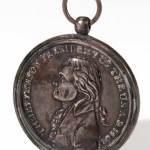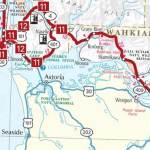Feliks: Uncovering the buried legacies of Lewis and Clark
Mar 22, 2023, 3:55 PM | Updated: 4:17 pm
Originally published March 23, 2016
While most people think of Oregon’s Fort Clatsop as the final destination of Lewis and Clark and the Corps of Discovery back in 1805, at least one Northwest historian and author disagrees with this interpretation.
David Nicandri, former director of the Washington State Historical Society, sees the Evergreen State as having played a much more vital role than Oregon.
“The whole narrative, the whole culminating drama of the cross-country trek, if one likes to think of it as an interstate contest,” said Nicandri, “all happens on the Washington side of the river.”
Related: Seattle radio station accidentally saves American history
From Nicandri’s perspective, those dozens of “Lewis and Clark Trail” signs along the Washington side of the Columbia River are there with good reason.
“The best way of thinking of Fort Clatsop,” Nicandri said, “is that contrary to popular impression, it’s not the end of the Lewis and Clark Trail, it’s better thought of as the first stop on the way home.”
As the 210th anniversary of Lewis and Clark leaving Fort Clatsop and heading for home is quietly marked this week, understanding of the impact and legacy of the Corps of Discovery is quietly evolving, too. From earlier oversimplified myths of heroic explorers sent by President Thomas Jefferson to ready the Northwest for American settlement, Lewis and Clark’s story has become more nuanced.
One aspect of the tale that isn’t nuanced at all are the reasons that Lewis and Clark decided to winter near the Pacific Ocean in 1805 in the first place.
David Nicandri says that the explorers found the coast more temperate than farther inland, and there were also plenty of elk to eat. The site for Fort Clatsop, south of present-day Astoria, Oregon, was chosen because elk were more plentiful there than on the north side of the Columbia River.
In addition to hunting elk and trying to keep dry, Nicandri says that the winter of 1805-1806 was a productive one for the explorers in terms of their administrative and scientific duties.
“Lewis did some of his best botanical work that winter at Fort Clatsop describing the various plants and animals that inhabit this part of the world,” Nicandri said. The explorers also caught up on what Nicandri calls “housekeeping” – editing and revising maps and drawings.
Nicandri describes the expedition as “fundamentally a geographic enterprise” concerned with “figuring out the relationship between the Missouri River system and the Columbia River system, which they did a reasonably good job at.” Though, Nicandri says, the pair were “literally shocked into silence by the realization that they hadn’t been on the main fork, that the main stem of the river came from the north.”
As it turned out, Alexander Mackenzie, whose expedition through Canada a decade earlier had inspired Thomas Jefferson, had already found the Columbia River’s headwaters on his 18th century expedition.
For Nicandri, these scientific activities are paramount to understanding and appreciating the most important point of the Lewis and Clark expedition.
“If there’s an essential aspect of that we should come to understand [about the Corps of Discovery], it’s the American attempt to participate in the Enlightenment era’s quest for understanding the world, its peoples, its geography, its natural processes, organic or otherwise,” Nicandri said. “That is what Lewis and Clark is most valuable for to study.”
The more nuanced understanding of Lewis and Clark comes in the wake of the bicentennial observances 10 years ago, along with publication of an exhaustive 13-volume edition of the famous expedition journals.
It was through careful study of these journals and years of other scholarship and field work that David Nicandri arrived at some of the conclusions in his own landmark 2009 book, “River of Promise: Lewis and Clark on the Columbia.”
Nicandri says that the elk that first made Fort Clatsop appealing were also the reason the explorers left on March 23, 1806. Lewis and Clark had originally intended to leave Fort Clatsop sometime in April in order to time their eastbound crossing of the snowy Bitterroot Mountains for the warmest months of the summer.
“As the weather warmed, the elk began to leave the neighborhood, and so Lewis and Clark figured ‘let’s get a head start on this’ and so they started moving upstream in March rather than in early April as they had planned,” Nicandri said.
While the more intangible legacies of Lewis and Clark continue to evolve, there’s one tangible though very rare legacy that remains a complicated symbol of the expedition and, perhaps more importantly, its effect on Native Americans.
Lewis and Clark gave gifts of “Peace and Friendship” medals to several Native Americans they met along the route. These medals are made mostly of silver and range in size from two to four inches in diameter. They show President Thomas Jefferson on one side. On the other side, along with the words, “Peace and Friendship,” is a Native hand and Caucasian hand clasped together, under a crossed pipe and hatchet.
David Nicandri says that creating medals for distribution by explorers or traders to Natives was common 200 years ago, but they’re worth looking at because they offer unique opportunities for cultural study. “They are a fascinating cultural and archaeological marker because they show up in all kinds of interesting places,” Nicandri said.
Among the interesting places that Peace and Friendship medals have turned up is on “Antiques Roadshow” in Oklahoma in 2003, and before that, at three different locations in the Pacific Northwest.
The earliest known find in the Northwest was circa 1891, likely on Goat Island on the Columbia River, near the confluence of the Walla Walla River. Circumstances of its discovery are unclear, but this medal was in the collection of the Oregon Historical Society (OHS) in Portland for more than a century. In 2009, it was transferred to the Confederated Tribes of the Umatilla Indian Reservation in Pendleton, Oregon. OHS collections manager Nicole Yasuhara wrote in an email that this took place under a federal law called the Native American Graves Protection and Repatriation Act or NAGPRA.
Another medal was found in 1899, when a construction crew working on a new railroad grade inadvertently unearthed Nez Perce graves at the mouth of Potlatch Creek in the Idaho Panhandle. That medal eventually made its way to the American Museum of Natural History in New York City.
In 1964, an archaeological dig managed by Washington State University found one in a grave in an area where a new bridge was to be built across the Snake River. WSU returned the medal to the Nez Perce Tribe in 1971, and it was loaned to the National Park Service museum in Spalding, Idaho where it was displayed for many years. However, the tribe ultimately reburied this particular medal in an undisclosed location just a few years ago.
Allen Pinkham, Sr. is 78 years old. He’s a Marine Corps veteran, and former chairman of the Nez Perce Tribe. He’d like the medal that was found in 1899 to be returned. Scholars theorize that Lewis and Clark likely bestowed the medal upon a Native American known as Cut Nose. Cut Nose is Allen Pinkham’s distant uncle.
“We could get the medal back and put it on display it if we want, or we could go and rebury it,” Pinkham said. “Whatever the desire is of the people.”
Roberto Lebron, senior director of communications for the American Museum of Natural History, confirmed this week via email that the medal remains in the museum’s collection. It is not currently on display.
In 2009, Pinkham asked the Nez Perce Tribal Council to formally request that the American Museum of Natural History return the medal found at Potlatch Creek, but the tribal council chose not to do so. The reasons for this decision are unclear.
For Pinkham, the words “peace and friendship” are far more than just a motto stamped into a silver coin. Beyond just a valuable artifact, the medal is a living symbol of what Lewis and Clark promised his ancestors 210 years ago.
“When Lewis and Clark came through our country, they were saying ‘peace and friendship.’ That was their message,” Pinkham said. “And we said ‘yes, the best way to be is to be peaceful and friendly.’ And of course, it didn’t work out that way.”
And this is a bit of an understatement. The history of the Nez Perce in the years after Lewis and Clark is particularly violent and sad, but not unlike the history of other tribes in the Northwest. It was these histories that moved Pinkham and other Native leaders to object to language used in the original plans of the Lewis and Clark Bicentennial Council when it was first getting organized back in the late 1990s.
Allen Pinkham was a member of the council, and he spoke up. “We got the council to change a word in their preamble from ‘celebrate’ to ‘commemorate,’ to commemorate the meeting and interaction with the tribes that Lewis and Clark did. We would commemorate that, but we would not celebrate it,” Pinkham said.
Whether or not the medal found at Potlatch Creek ever returns to Idaho, Allen Pinkham says that the Nez Perce people are doing more for themselves these days, relying less on federal agencies such as the Bureau of Indian Affairs, and returning more to their historic roots.
“We’re contributing to the economy in our own country, which we were doing at the time of Lewis and Clark,” Pinkham said.
According to Allen Pinkham, much of the tribe’s approach relates to that promise the Nez Perce people still take seriously, a promise on the back of a medal that their ancestors first saw more than two centuries ago.
“We own the medal as tribal people, and we have to remind people sometimes that we are here in peace and friendship, just like we were over 200 years ago,” he said.
You can hear Feliks every Wednesday and Friday morning on Seattle’s Morning News with Dave Ross and Colleen O’Brien, read more from him here, and subscribe to The Resident Historian Podcast here. If you have a story idea, please email Feliks here.


















